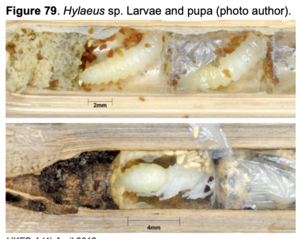Brood Cell Microcosm: Difference between revisions
No edit summary |
No edit summary |
||
| Line 6: | Line 6: | ||
Aculeate Wasp Life Cycle and Development: | |||
---- | |||
Revision as of 10:05, 13 April 2021
The nests of solitary wasp species (including everybody's favorite pollen-collecting solitary wasps "the bees") are known as brood cells. Depending on the species observed these cells can be found in underground chambers, hollow twigs, sculpted with mud, or even crammed inside abandoned snail shells. These cells that female wasps provision with a food source and lay an egg in, don't stop interacting with the environment once they are sealed. The microcosm formed when a mother wasp seals a finished brood cell is home to a plethora of ancient co-evolved relationships that can beneficially or negatively affect the health of the egg/larvae found in the nest. Brood cell mutualists and parasites span across many taxa; from yeasts and bacteria that negatively affect the health of the occupant, all of the way to mutualistic prostigmatic mites that fend off/eat infectious fungi.
Aculeate Wasp Life Cycle and Development:
Members of Brood Cell Microcosm:
Bacteria and Yeast:
Fungi:
Nematodes:
Mites:
